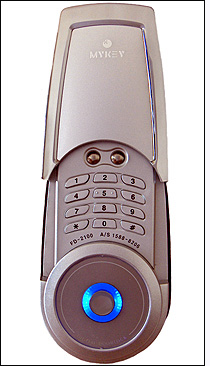When GlobalComm Suppliers, a cell phone distributor near Philadelphia, moved into a new office space in 2004, it didn’t want to rely on the low-tech, key-driven deadbolt on the door to protect the office’s high-tech contents. Therefore, the company sought out and found a lock it believed would be tougher to crack: an RFID-controlled deadbolt. If that sounds similar to the RFID access-control systems used widely to secure offices buildings, that’s because it is. But rather than installing a large network of linked, centrally controlled interrogators (readers), GlobalComm found a small, single-door unit designed for home or small office use, called MyKey 2300.
The product consists of a small, 13.56 MHz interrogator linked to a deadbolt that is mountable on any standard doorframe. After installing it, GlobalComm saw an opportunity: While MyKey—manufactured by a Korean company called Firstech—had been selling well through distributors and retails shops in Singapore and Malaysia for a few years, it did not yet have a U.S. distributor.
“It’s an innovative product,” says Dennis O’Donnell, vice president of GlobalComm Suppliers. So the company decided to augment its main cell-phone distribution services by importing and selling the device. GlobalComm put up a Web site and started selling MyKey 2300 just under a year ago. Sales, however, haven’t been as brisk as the company had hoped, paling when compared with those in Asia.
Frederick Chong, who calls himself the “digital locksmith” for MyKey2300’s Asian distributor, The Gadget Home, says his sales of the lock system have been increasing for the past 18 months. The company now sells about 40 units each month—more than all other types of keyless locks it sells, combined.
O’Donnell says one of MyKey’s marketing hurdles in the United States has been its unknown brand. U.S. consumers, he says, look for security and lock products bearing such recognizable brands as Schlage. He also chalks up the soft sales to a general “distrust of new things and a distrust of products coming from Asia.” Though many consumer products are made in Asia, he explains, such products tend to carry a negative—but false—connotation in America for being cheaply made.
Still, O’Donnell is hopeful that consumers in the United States will warm to the idea of keyless locks for home and office, which they can install and control themselves, and which can’t be picked like traditional locks. The MyKey unit unlocks when presented with an ISO 14443 RFID tag encoded with a 40-bit ID found on the interrogator’s database of accepted tags.
The product comes with six tags, each embedded in a plastic card, but the user can purchase up to 44 more, as an interrogator can be programmed to recognize up to 50 IDs. The system also comes with two tags with an adhesive backing that can be attached to cell phones and other items. To remove an ID from the interrogator’s database, the user must present the tag to the reader. If a user loses his or her tag, however, it is recommended that the interrogator’s cache of accepted ID be cleared and the reader be reprogrammed to accept only the remaining tags still in use.
The ISO 14443 tags used have a read range of a few inches. The interrogator runs on four AA batteries, which should keep it powered for up to a year with normal use. To conserve energy, the interrogator turns itself off whenever not in use. To unlock the door, the user presses a button mounted outside the door, activating the interrogator, then presents the tag.
A keypad, built into the same casing that houses the button, can be used to open the lock through a personal identification number of up to 20 digits. Long utilized for office-building access and (until RFID fobs came into vogue) automobiles, keypad door locks are now starting to be installed by homeowners. Popular brand Kwikset is selling a keypad lock, and Schlage will be selling one soon, as well; both makers’ keypad models, however, also have a traditional keyhole as a backup means of entry.
O’Donnell admits that the system, like other RFID-based access-control systems, could be vulnerable to hacking. He doubts, however, that users of the MyKey system—himself included—are likely to be identified and followed by a nefarious party carrying a covert interrogator, who might get close enough to the carrier’s key tag to make a clone with the intent of using it to break into that person’s home or office. Moreover, if he or anyone in his office misplaces a key tag, resetting the interrogator’s ID database and making the lost one invalid is faster than replacing the lock—and costs only a few minutes of time.


